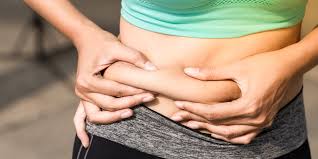THE FAT BURNING THEORY
In my earlier blog on Energy Balance, the following formula was given:
Energy Balance = Energy Intake minus Energy Expenditure*
*Energy Expenditure:
- BMR – Basal Metabolic Rate
- RMR – Resting Metabolic Rate
- AE – Activity Expenditure
- TEF – Thermic Effect of Food
We looked at each component of Energy Expenditure comprised of total calories burned during sleep (BMR), resting metabolism when you are awake (RMR), exercise/activity expenditure based on the intensity and duration of a workout session (AE) and finally the thermic effect of food (TEF), which is effectively achieved by consuming lean protein and fibrous carbohydrates, leading to increased body temperature while ingesting food and burning more calories.
In this blog, we will focus on Activity Expenditure and how to use it in order to burn more fat. Simply put, your heart rate elevates during exercise and when you rest, it decreases; but depending on your training intensity, your heart rate should be constantly increasing.
Metabolism Systems Review
If you’re doing high-powered activities lasting 10 - 15 seconds, the main energy source used will be adenosine triphosphate (ATP) and creatine phosphate (CP) via the phosphagen system. Your heart rate will increase above 95% of its maximum capacity and the main muscles recruited will be the fast which muscles or type IIX fibers that are used for explosive and fast activities. Your body will need 2-5 minutes to fully recover.
When moderate-powered activities are performed between 15 - 90 seconds, the glycolytic metabolism is activated. Here, the main energy source is glucose and glycogen that support this longer duration workout at moderate-high intensities. A 92-95% maximum heart-rate will be reached and type IIA fibers that have endurance and power capacity will be recruited. Your body will need 1-3 min for full recovery. These two metabolic systems, the phosphagen and the glycolytic, are known collectively as anaerobic.
Finally, when low powered activities lasting above 90 seconds are performed, the aerobic or fat burning metabolism is activated by relying on carbohydrates, proteins and fat in the presence of oxygen to provide energy. This allows for continual low force production compared to the previous 2 metabolisms without rest, as long as the energy is available. Type I fibers are recruited, which have high endurance, low power capacity.
Aerobic Training for Fat Burning

The classic method of measuring the fat burning zone is to apply the direct method formula to find the lower and upper limit of the heart rate intensity. The fat burning range will be 70-80% of your maximum heart-rate.
By way of example, the fat burning zone for a 30 year old would be:
Max HR = 220 - age
Max HR = 220 – 30 = 190 Bpm (Beats per minute)
The lower limit of fat burning = 190 x 70% = 133 Bpm
The higher limit of fat burning = 190 x 80% = 152 Bpm
For a more accurate measure, you can add 14 to each of the limits:
The lower limit of fat burning = 133 + 14 = 147
The higher limit of fat burning = 152 + 14 = 166
So in order to burn fat, your heart rate should remain between 147 and 166 Bpm.
But this method is time consuming and can lead to boredom. In order to lose weight using this method, you will need to do an aerobic exercise for 30-60 minutes per day, 5-7 days per week.
What if I tell you that you can burn more calories in less amount of time and without losing muscle?
Aerobic exercise is widely recognized as being ideal for fat loss, but recent studies have shown that anaerobic exercise is a vastly superior protocol for fat burning.
Anaerobic exercises build muscle while aerobic exercises burn muscle.
Anaerobic Training for Fat Burning
Anaerobic training is beneficial to aerobic performance and can be used to develop high levels of aerobic fitness without the usual muscle wastage. This can be accomplished through interval and sports training.
While your fat is metabolically inert, your lean muscle tissue contributes significantly to your resting metabolic rate, increasing your total daily caloric expenditure. To put it simply, the more muscle you have, the higher your metabolism, and the more calories you burn throughout the day. Weight training is generally considered anaerobic exercise, and because of its effect on metabolism both during AND after training, it may significantly impact fat loss. Studies attribute some of the fat-burning effect of resistance training to increases in the hormones epinephrine, norepinephrine and the growth hormone, which play an important role in fat metabolism.
High Intensity Workouts For Fat Burning
High-intensity interval training combines aerobic and anaerobic exercise to boost metabolism and improve cardio respiratory endurance. It combines a short bout of high-intensity anaerobic activity with brief aerobic periods of low intensity activity. For example, a simple workout can combine 60 seconds of sprinting, followed by 60 seconds of walking, and repeating this cycle for 25 minutes or longer. Studies have demonstrated that interval training has a significant impact on both aerobic and anaerobic fitness, since repeated bouts of exercise with a shorter duration have been found to increase fat metabolism more than a single bout of prolonged exercise.
Final thoughts
Aerobic, anaerobic and muscle training are essential for fat loss and to keep your body free from injuries and in good cardiovascular health.
My suggestion is to perform weight training 2-3 times per week, accompanied by a high intensity interval session at the end of the workout. Try to do 3 sets of 6-10 exercises for optimal fat burning and compound exercises rather than isolated moves to activate more muscles and burn more calories from fat.
Another good idea is to do circuit training with a low period of rest between exercises to increase your heart rate and burn more calories. Circuit training can be implemented in weight training and contains a combination of body weight exercises, conditioning and agility drill exercises and compound exercises.
If you have time for additional training, 1-2 long aerobic sessions can be added to improve your cardiovascular endurance and aid your recovery from a previous intense workout, while burning fat by using the classical method formula.
The important point to conclude this article is that variation is key in exercising to reach your goals and enjoy a healthier, more interesting lifestyle.



